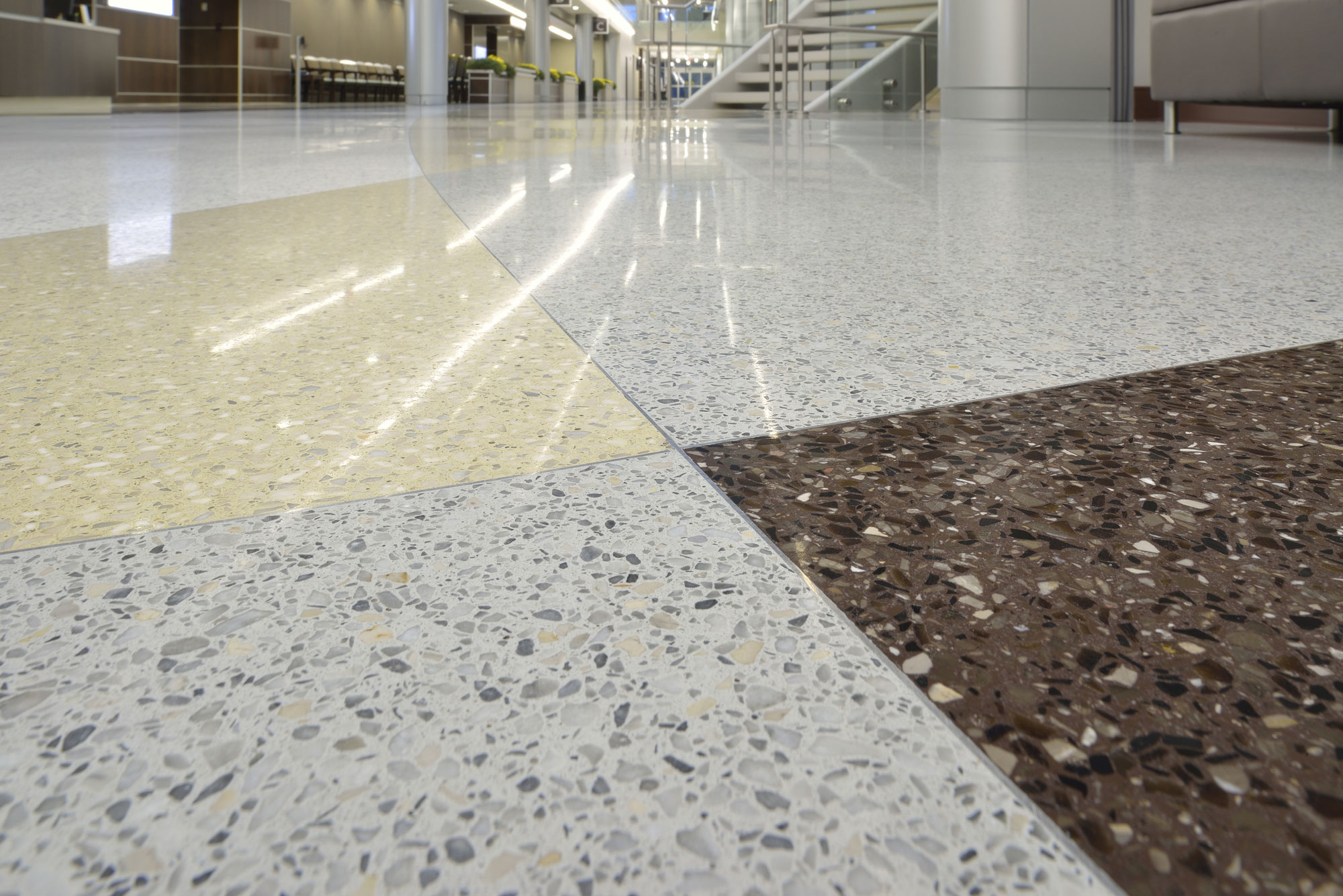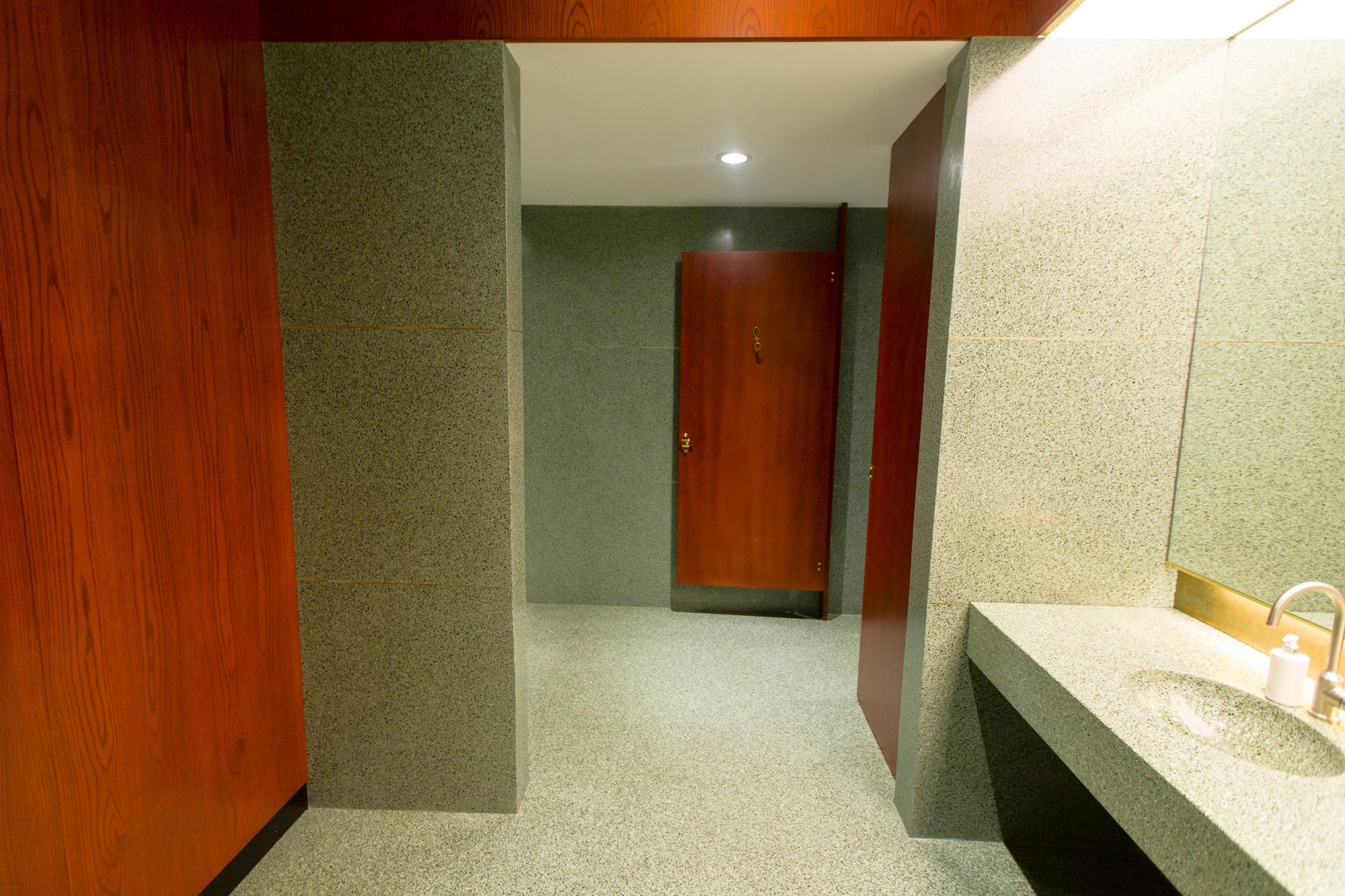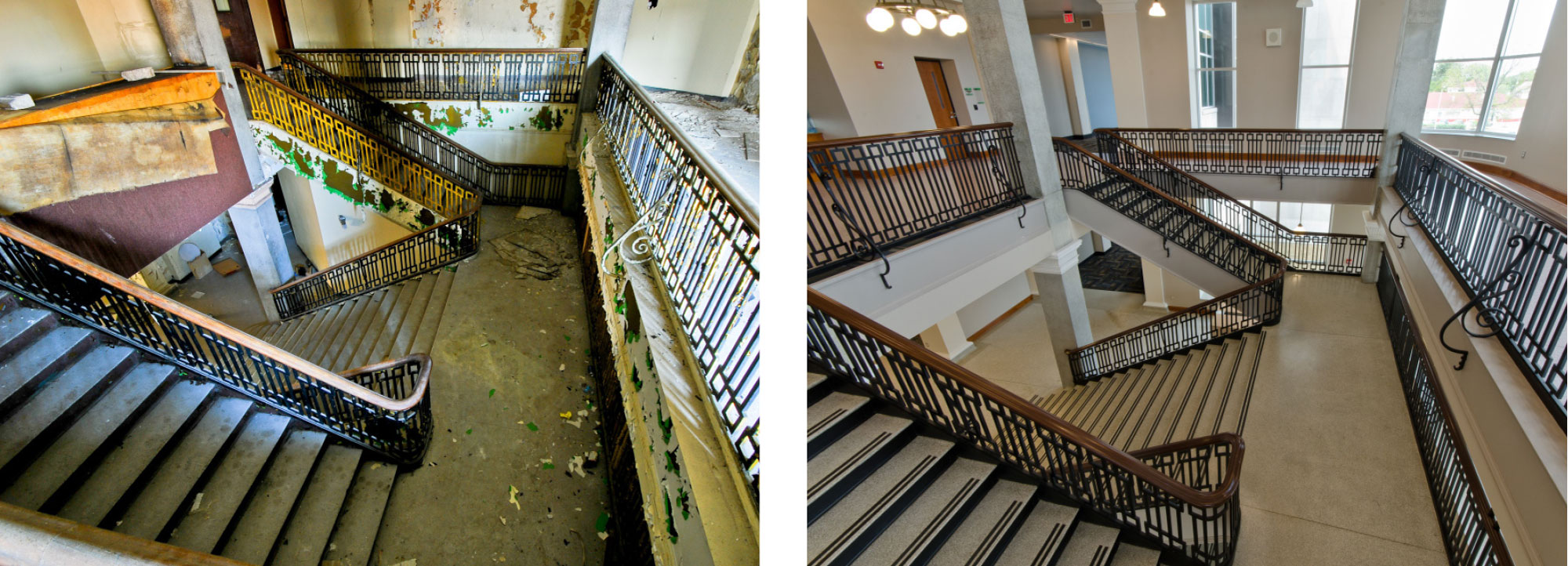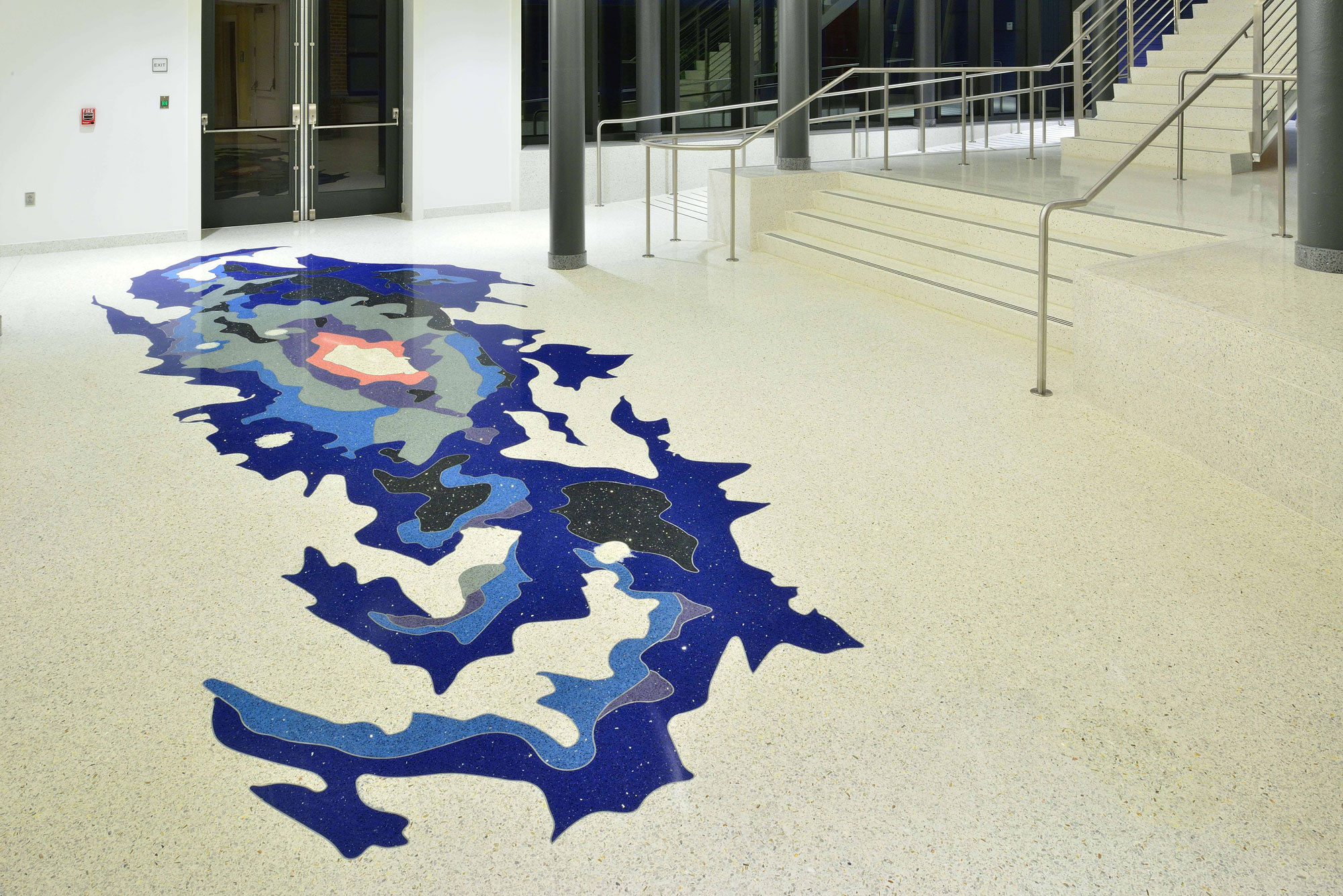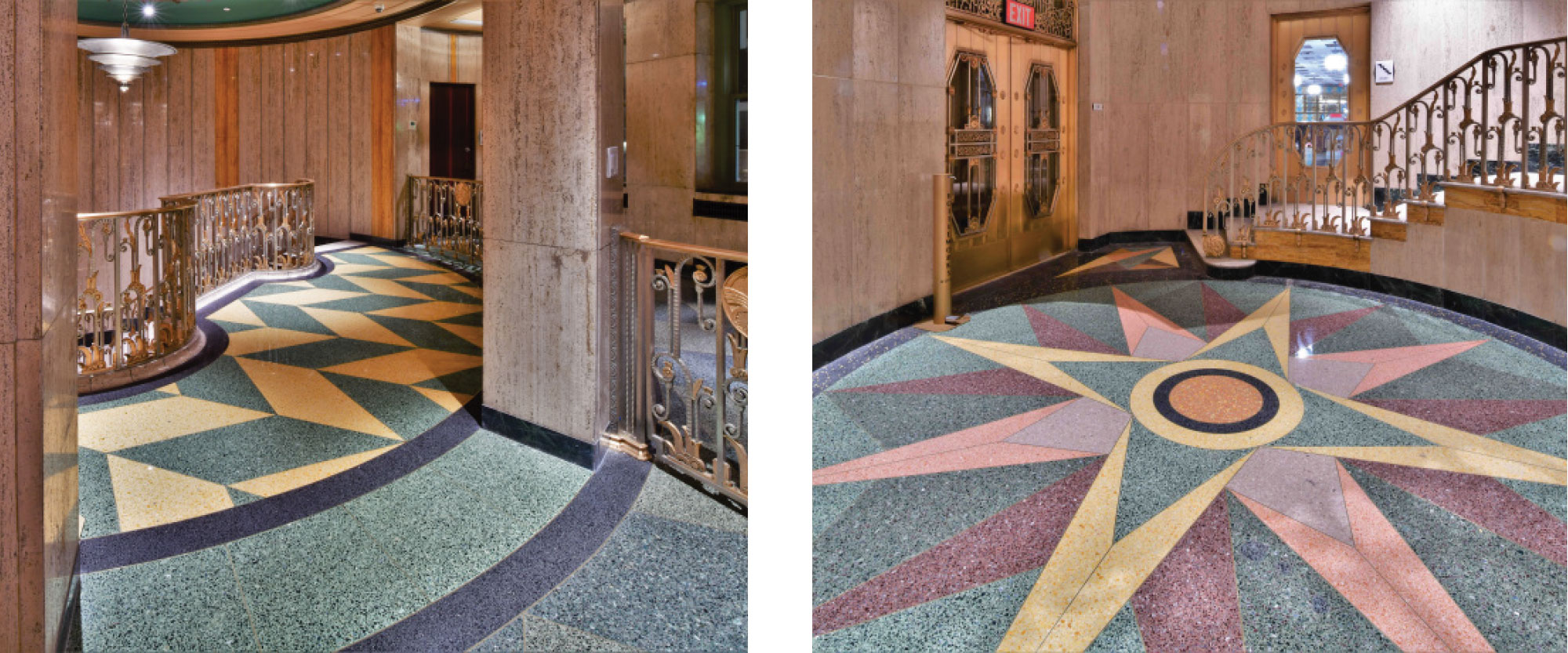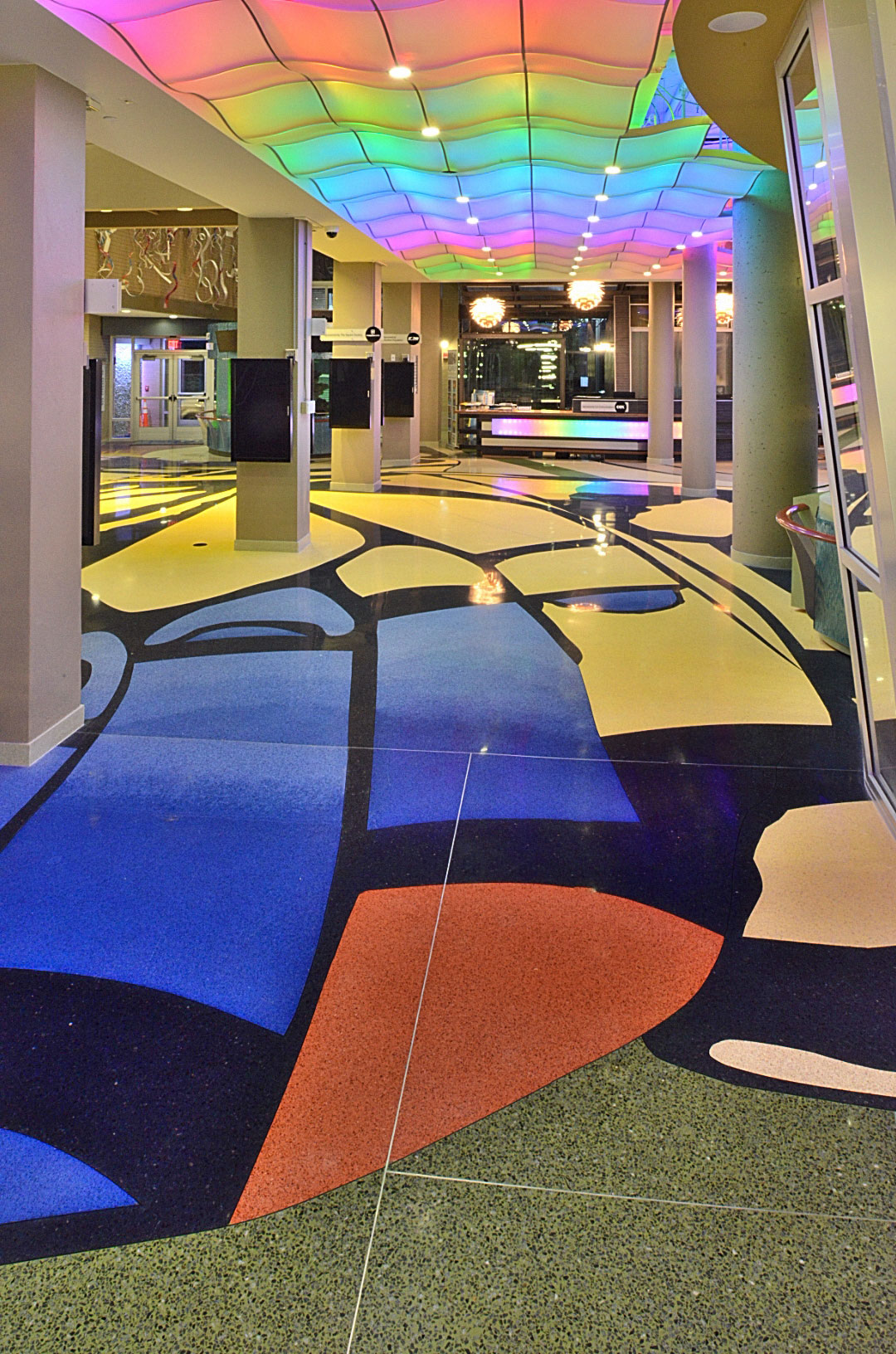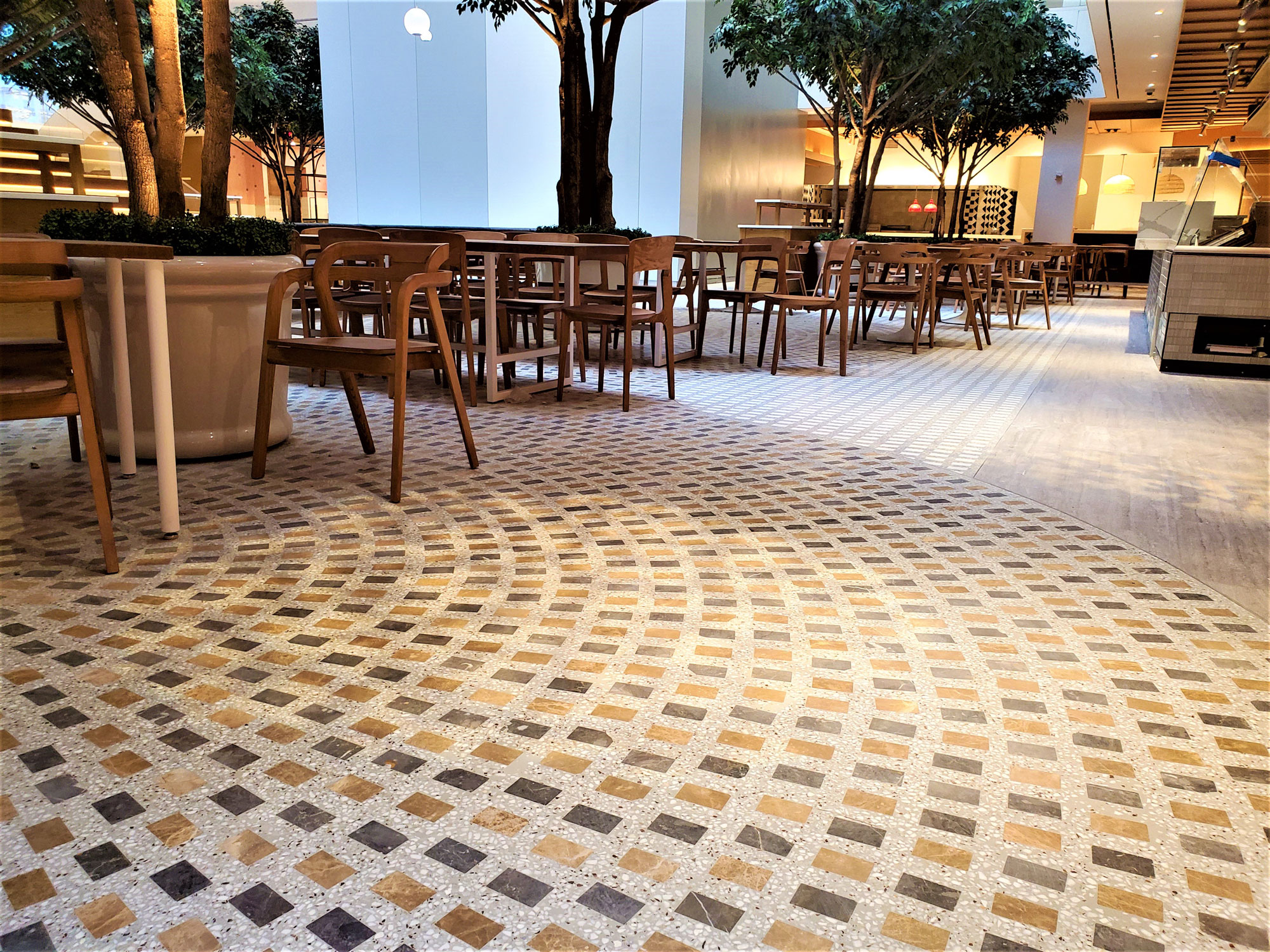This CE Center article is no longer eligible for receiving credits.
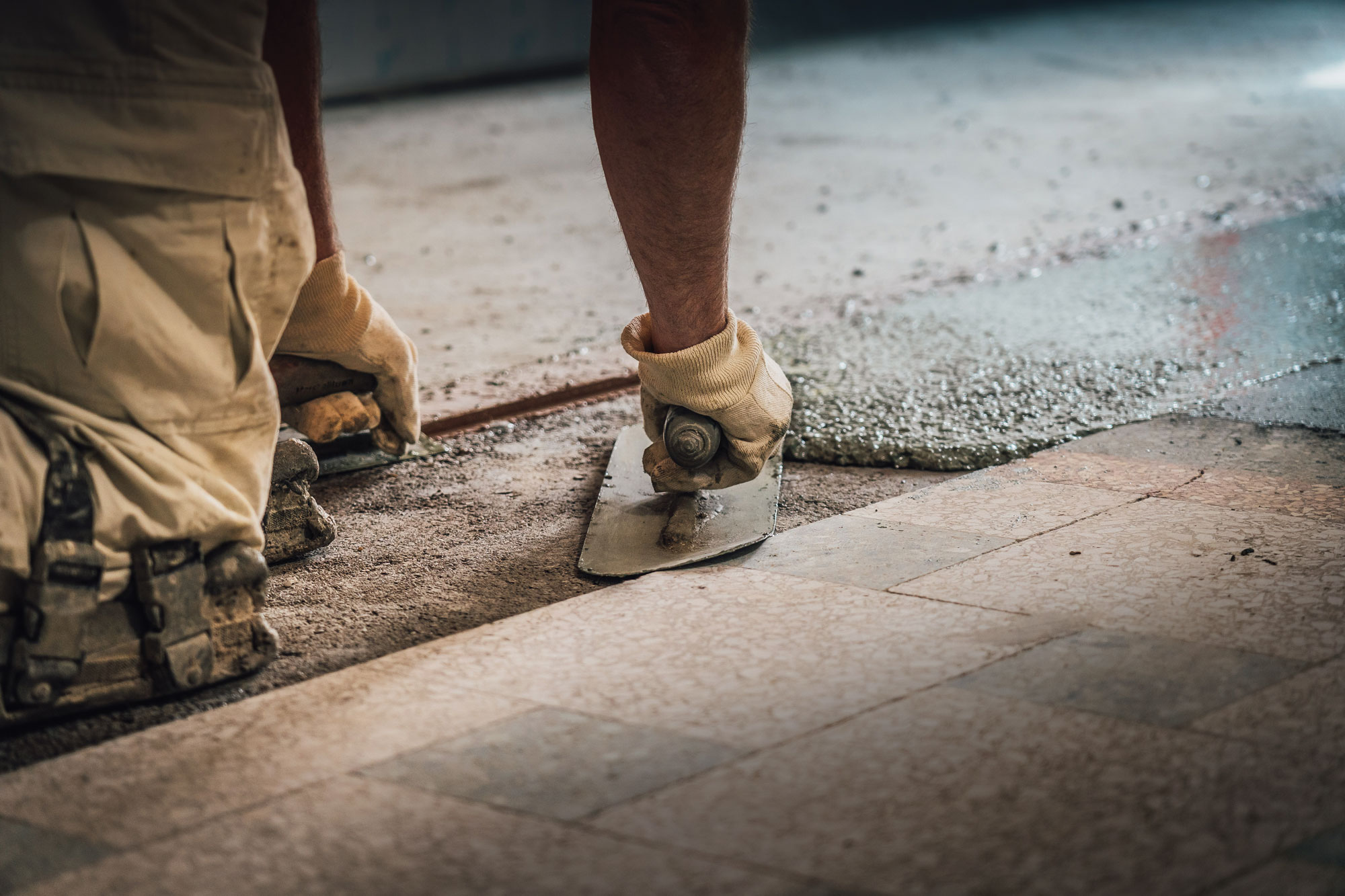
Photo courtesy of FotoGrafix Viken Djarferian
As part of an adaptive reuse of Chicago's 106-year-old Cook County Hospital, led by Skidmore, Owings & Merrill and Koo Architecture, the terrazzo contractor preserved and restored the original cement terrazzo tiles, carefully matching and complementing them with poured-in-place epoxy terrazzo. Simulated grout joints were cut to replicate the original design.
INTRODUCTION TO TERRAZZO AND ADAPTIVE REUSE
Repurposing buildings is more than simple nostalgia; it’s smart sustainability. Adaptive reuse leverages the value of existing structures, revitalizing old, neglected, or underused built assets as functional environments, thus avoiding the costs and environmental impact of demolition and rebuilding.
Terrazzo exemplifies this philosophy with its capacity to be restored and layered over existing surfaces and create precise color matches to existing design elements. Specifying terrazzo means embracing a legacy of durability, versatility, and environmental responsibility, ensuring that the old becomes new again, beautifully and elegantly.
By retrofitting and updating structures, adaptive reuse restores prime real estate to productive, attractive spaces, optimizing its performance while playing a crucial role in urban revitalization. This approach aligns with sustainable development principles and is both financially advantageous and environmentally responsible. Renovating and adapting buildings for new uses brings value to the community, creating spaces that meet contemporary needs while preserving historical and architectural heritage.
INTRODUCTION TO TERRAZZO
A. What is Terrazzo?
Terrazzo is a composite material traditionally made of a cement binder, but more commonly today, a resinous matrix mixed with aggregates of natural stone, recycled glass, mother-of-pearl, or other natural or synthetic material. The design-flexible epoxy system, thinner and lighter than the cement system with a sand cushion, has become the system of choice for most installations.
Unlike manufactured products, terrazzo is installed using the in-situ method, where raw materials are combined and poured directly onto the floor, with flexibility and versatility to create custom designs. Once cured, the surface is ground to a smooth, hard finish. Terrazzo can also be applied to walls, ceilings, stairs, curbs, panels, and countertops, whether applied by hand on-site or as precast elements, offering a durable and versatile surface.
Divider strips—typically made of zinc, aluminum, brass, plastic, or even another color of terrazzo—are used to separate colors and create patterns. For more intricate designs, strips can be waterjet-cut, while epoxy terrazzo can be poured without divider strips for seamless, free-form patterning.
Terrazzo supports human health, safety, and welfare by being a durable, low-maintenance material that promotes better air quality due to its non-porous, VOC-free composition. Its slip-resistant surface enhances safety in high-traffic areas, while its longevity reduces the need for replacements, eliminating disruption in work, travel, and learning environments and contributing to sustainable, healthier environments.
B. History and Evolution of Terrazzo
Terrazzo techniques are rooted in traditional Old-World craftsmanship. For centuries, terrazzo in various renditions has been used for flooring and wall surfaces, with origins tracing back to ancient Egypt and Rome. Its current iteration first took shape in Venice, as marble workers reinterpreted mosaic artistry, placing marble remnants in a mortar base or spreading marble chips into cement, followed by grinding and polishing.
The in-situ method of pouring terrazzo in place exemplifies this hand-crafted tradition. These techniques maintain their historical roots alongside modern design innovations and advanced installation technology.
Italian immigrants introduced terrazzo to the United States in the 1890s, and it gained popularity in the 1920s as technological advancements reduced costs and improved quality. Designers were drawn to its design flexibility and compatibility with Art Deco styles. The introduction of divider strips in 1924 reduced cracking while enhancing design versatility. During this period, the development of electric grinding machines also significantly improved efficiency, reducing installation costs and time.
As terrazzo’s popularity and affordability increased, the industry flourished. The National Terrazzo and Mosaic Association (NTMA) was established in 1923. Today, the NTMA, headquartered in Fredericksburg, Texas, is a full-service, non-profit trade association that has led the industry through continuous advancements over the past century and continues to set national standards for all terrazzo systems. NTMA members are qualified, approved contractors. The NTMA supplies comprehensive specifications, color plates, and general information to architects and designers, also serving as an authoritative third-party resource as needed for all parties in a project at no cost. Personalized guidance and assistance from the association’s technical director is offered free of charge.
BENEFITS OF TERRAZZO IN ADAPTIVE REUSE PROJECTS
Terrazzo offers many assets for adaptive reuse. A sustainable material, it can be customized in design and adapted to the constraints of existing spaces. Its low maintenance requirements translate to long-term cost savings, and its durability and longevity ensure a cost-effective lifecycle.
A. Sustainability and Environmental Impact of Terrazzo
“Terrazzo offers many fiscally and environmentally friendly assets,” explained Robyn Toth, principal and owner at TCA Architects in Crownsville, Maryland. Terrazzo is a hard, seamless flooring with a permanent finish that lasts for decades, conserving resources over time. Epoxy resin contains no Portland cement. Its nonporous finish is impervious to moisture and microbial growth.
Terrazzo systems routinely incorporate local and recycled materials, from reclaimed glass and local stone aggregates to repurposed marble or other elements from remodeled interiors. Recycled concrete has been creatively used for aggregate. Terrazzo is VOC-free, contributing to a healthier indoor environment. It is formulated without formaldehyde or harmful chemicals, ensuring minimal to no outgassing before, during, or after installation. Additionally, terrazzo requires no paints, coatings, adhesives, or sealants that could release volatile organic compounds. Terrazzo can be installed in occupied spaces without adversely affecting occupants, reflecting its minimal impact on indoor air quality.
Terrazzo is a resilient building material that can be restored and repaired indefinitely to conserve historic and new installations without total replacement, thereby reducing landfill waste. Extending the life of an existing terrazzo surface conserves resources exponentially. It avoids the considerable costs of demolition, clean-up, removal of old materials, time, energy use, and the mess of demolition and pouring a new concrete slab.
Furthermore, terrazzo can be installed over different floor systems with nominal substrate correction, thus avoiding the considerable costs, waste, and mess of demolition. Leaving the old floor in place is also an environmental advantage, saving tons of waste from going to landfills.
B. Lifecycle Advantages
1. Permanent vs. Replaced Floors
“Owners can get caught up in first costs,” explained Ms. Toth. “Walk them through 20 years of operating and maintenance costs, and terrazzo becomes a much stronger candidate.” The bulk of the savings come from maintenance costs drastically lower than many flooring materials and eliminating flooring replacements for the life of the facility. Terrazzo’s cost benefits have made it the preferred flooring of many public schools, state universities, and government buildings.
Lifecycle costs for a permanent, seamless, custom-designed, low-maintenance terrazzo floor are leveled with just one carpet or vinyl replacement. Terrazzo also avoids the immense costs and downtime associated with floor replacement, even in the highest-traffic areas. Removal and disposal of replaced flooring are other expenses and environmental impacts to consider. High-traffic environments may have to replace carpet or vinyl as often as every five years, triggering costly planning, disruption, and waste. A material that lasts conserves resources long-term.
2. Maintenance and Care of Terrazzo
A terrazzo floor requires only sweeping and damp mopping with a pH-balanced cleaner with no harsh chemicals. As soon as terrazzo is installed, its considerable maintenance savings begin to balance out the initial costs, which may be higher than some other options.
Comparing terrazzo’s maintenance costs with those for VCT, for example, it can be estimated that for a 100,000-square-foot terrazzo floor, the maintenance per year is $56,000, with a 30-year total cost of $2.9 million.1 For VCT, maintenance is estimated at $135,000 annually and a total 30-year expenditure of $4.3M.
Installation costs of terrazzo and VCT break even at around 12.5 years, around the end of a typical VCT floor’s usefulness. From the point when a VCT requires replacement, a terrazzo floor’s savings accelerate and continue to bear return the longer a terrazzo floor is in service.
Terrazzo maintenance advantages:
- Solid-surface terrazzo maintains its condition and looks good longer than softer synthetic materials.
- Simple, minimal, cost-effective maintenance schedule saves on labor, chemicals, and water.
- Resistant to abuse, heavy loads, and high traffic.
- A seamless, non-absorbent, nonporous surface free of grout joints resists microbial growth and moisture accumulation, resulting in a consistently cleaner floor.
- An integral cove base around walls and columns can provide a tough, protective transition to vertical surfaces and prevent dirt build-up.

Photo courtesy of FotoGrafix Viken Djarferian
As part of an adaptive reuse of Chicago's 106-year-old Cook County Hospital, led by Skidmore, Owings & Merrill and Koo Architecture, the terrazzo contractor preserved and restored the original cement terrazzo tiles, carefully matching and complementing them with poured-in-place epoxy terrazzo. Simulated grout joints were cut to replicate the original design.
INTRODUCTION TO TERRAZZO AND ADAPTIVE REUSE
Repurposing buildings is more than simple nostalgia; it’s smart sustainability. Adaptive reuse leverages the value of existing structures, revitalizing old, neglected, or underused built assets as functional environments, thus avoiding the costs and environmental impact of demolition and rebuilding.
Terrazzo exemplifies this philosophy with its capacity to be restored and layered over existing surfaces and create precise color matches to existing design elements. Specifying terrazzo means embracing a legacy of durability, versatility, and environmental responsibility, ensuring that the old becomes new again, beautifully and elegantly.
By retrofitting and updating structures, adaptive reuse restores prime real estate to productive, attractive spaces, optimizing its performance while playing a crucial role in urban revitalization. This approach aligns with sustainable development principles and is both financially advantageous and environmentally responsible. Renovating and adapting buildings for new uses brings value to the community, creating spaces that meet contemporary needs while preserving historical and architectural heritage.
INTRODUCTION TO TERRAZZO
A. What is Terrazzo?
Terrazzo is a composite material traditionally made of a cement binder, but more commonly today, a resinous matrix mixed with aggregates of natural stone, recycled glass, mother-of-pearl, or other natural or synthetic material. The design-flexible epoxy system, thinner and lighter than the cement system with a sand cushion, has become the system of choice for most installations.
Unlike manufactured products, terrazzo is installed using the in-situ method, where raw materials are combined and poured directly onto the floor, with flexibility and versatility to create custom designs. Once cured, the surface is ground to a smooth, hard finish. Terrazzo can also be applied to walls, ceilings, stairs, curbs, panels, and countertops, whether applied by hand on-site or as precast elements, offering a durable and versatile surface.
Divider strips—typically made of zinc, aluminum, brass, plastic, or even another color of terrazzo—are used to separate colors and create patterns. For more intricate designs, strips can be waterjet-cut, while epoxy terrazzo can be poured without divider strips for seamless, free-form patterning.
Terrazzo supports human health, safety, and welfare by being a durable, low-maintenance material that promotes better air quality due to its non-porous, VOC-free composition. Its slip-resistant surface enhances safety in high-traffic areas, while its longevity reduces the need for replacements, eliminating disruption in work, travel, and learning environments and contributing to sustainable, healthier environments.
B. History and Evolution of Terrazzo
Terrazzo techniques are rooted in traditional Old-World craftsmanship. For centuries, terrazzo in various renditions has been used for flooring and wall surfaces, with origins tracing back to ancient Egypt and Rome. Its current iteration first took shape in Venice, as marble workers reinterpreted mosaic artistry, placing marble remnants in a mortar base or spreading marble chips into cement, followed by grinding and polishing.
The in-situ method of pouring terrazzo in place exemplifies this hand-crafted tradition. These techniques maintain their historical roots alongside modern design innovations and advanced installation technology.
Italian immigrants introduced terrazzo to the United States in the 1890s, and it gained popularity in the 1920s as technological advancements reduced costs and improved quality. Designers were drawn to its design flexibility and compatibility with Art Deco styles. The introduction of divider strips in 1924 reduced cracking while enhancing design versatility. During this period, the development of electric grinding machines also significantly improved efficiency, reducing installation costs and time.
As terrazzo’s popularity and affordability increased, the industry flourished. The National Terrazzo and Mosaic Association (NTMA) was established in 1923. Today, the NTMA, headquartered in Fredericksburg, Texas, is a full-service, non-profit trade association that has led the industry through continuous advancements over the past century and continues to set national standards for all terrazzo systems. NTMA members are qualified, approved contractors. The NTMA supplies comprehensive specifications, color plates, and general information to architects and designers, also serving as an authoritative third-party resource as needed for all parties in a project at no cost. Personalized guidance and assistance from the association’s technical director is offered free of charge.
BENEFITS OF TERRAZZO IN ADAPTIVE REUSE PROJECTS
Terrazzo offers many assets for adaptive reuse. A sustainable material, it can be customized in design and adapted to the constraints of existing spaces. Its low maintenance requirements translate to long-term cost savings, and its durability and longevity ensure a cost-effective lifecycle.
A. Sustainability and Environmental Impact of Terrazzo
“Terrazzo offers many fiscally and environmentally friendly assets,” explained Robyn Toth, principal and owner at TCA Architects in Crownsville, Maryland. Terrazzo is a hard, seamless flooring with a permanent finish that lasts for decades, conserving resources over time. Epoxy resin contains no Portland cement. Its nonporous finish is impervious to moisture and microbial growth.
Terrazzo systems routinely incorporate local and recycled materials, from reclaimed glass and local stone aggregates to repurposed marble or other elements from remodeled interiors. Recycled concrete has been creatively used for aggregate. Terrazzo is VOC-free, contributing to a healthier indoor environment. It is formulated without formaldehyde or harmful chemicals, ensuring minimal to no outgassing before, during, or after installation. Additionally, terrazzo requires no paints, coatings, adhesives, or sealants that could release volatile organic compounds. Terrazzo can be installed in occupied spaces without adversely affecting occupants, reflecting its minimal impact on indoor air quality.
Terrazzo is a resilient building material that can be restored and repaired indefinitely to conserve historic and new installations without total replacement, thereby reducing landfill waste. Extending the life of an existing terrazzo surface conserves resources exponentially. It avoids the considerable costs of demolition, clean-up, removal of old materials, time, energy use, and the mess of demolition and pouring a new concrete slab.
Furthermore, terrazzo can be installed over different floor systems with nominal substrate correction, thus avoiding the considerable costs, waste, and mess of demolition. Leaving the old floor in place is also an environmental advantage, saving tons of waste from going to landfills.
B. Lifecycle Advantages
1. Permanent vs. Replaced Floors
“Owners can get caught up in first costs,” explained Ms. Toth. “Walk them through 20 years of operating and maintenance costs, and terrazzo becomes a much stronger candidate.” The bulk of the savings come from maintenance costs drastically lower than many flooring materials and eliminating flooring replacements for the life of the facility. Terrazzo’s cost benefits have made it the preferred flooring of many public schools, state universities, and government buildings.
Lifecycle costs for a permanent, seamless, custom-designed, low-maintenance terrazzo floor are leveled with just one carpet or vinyl replacement. Terrazzo also avoids the immense costs and downtime associated with floor replacement, even in the highest-traffic areas. Removal and disposal of replaced flooring are other expenses and environmental impacts to consider. High-traffic environments may have to replace carpet or vinyl as often as every five years, triggering costly planning, disruption, and waste. A material that lasts conserves resources long-term.
2. Maintenance and Care of Terrazzo
A terrazzo floor requires only sweeping and damp mopping with a pH-balanced cleaner with no harsh chemicals. As soon as terrazzo is installed, its considerable maintenance savings begin to balance out the initial costs, which may be higher than some other options.
Comparing terrazzo’s maintenance costs with those for VCT, for example, it can be estimated that for a 100,000-square-foot terrazzo floor, the maintenance per year is $56,000, with a 30-year total cost of $2.9 million.1 For VCT, maintenance is estimated at $135,000 annually and a total 30-year expenditure of $4.3M.
Installation costs of terrazzo and VCT break even at around 12.5 years, around the end of a typical VCT floor’s usefulness. From the point when a VCT requires replacement, a terrazzo floor’s savings accelerate and continue to bear return the longer a terrazzo floor is in service.
Terrazzo maintenance advantages:
- Solid-surface terrazzo maintains its condition and looks good longer than softer synthetic materials.
- Simple, minimal, cost-effective maintenance schedule saves on labor, chemicals, and water.
- Resistant to abuse, heavy loads, and high traffic.
- A seamless, non-absorbent, nonporous surface free of grout joints resists microbial growth and moisture accumulation, resulting in a consistently cleaner floor.
- An integral cove base around walls and columns can provide a tough, protective transition to vertical surfaces and prevent dirt build-up.
C. Design Versatility and Customization Options
“Beyond the obvious—cost-effectiveness, ease of maintenance, durability, low environmental impact, contribution to LEED certification with indoor air quality, sustainability, regional sourcing—as a designer, it’s the capacity for expression, from very dynamic to subtle. Terrazzo provides the opportunity for infinite flexibility for message-driven content that creates visual interaction between users and their environment,” stated Anita Ambriz of Ambriz Graphic Design.
Terrazzo Design Advantages for Adaptive Reuse:
- Custom design capabilities, from classic to creative.
- Infinite options for aggregate type, size, and density percentage in the mix.
- Facilitates designing a cohesive interior, which simplifies long-term maintenance.
- Unlimited colors easily match any paint color or existing finish to coordinate with existing design elements, including historic terrazzo.
- Branding, logos, patterns, and colors can be permanently integrated.
- Interior design can be enhanced on the floor rather than at eye level.
- Compatible with radiant floor and induction loop systems.
- Terrazzo’s variegated texture can also help camouflage dirt and scuffs, sustaining a presentable appearance longer in high-traffic zones.
- The smooth surface makes mobility devices, wheeled carts, and luggage noiseless and easy to maneuver.
TECHNICAL CONSIDERATIONS FOR TERRAZZO FLOORING
A. Epoxy vs. Cement-Based Terrazzo Systems
Today, epoxy terrazzo accounts for approximately 95 percent of current interior installations, replacing the traditional cementitious terrazzo, which, with a sand cushion, is unsuitable for retrofit due to its thickness. The monolithic and bonded cement-based systems are thinner options. First used with terrazzo in the 1960s, epoxy is relatively thin, lightweight, extremely durable, and sustainable and offers the quickest pour-to-grind installation time and unlimited design options.
Epoxy terrazzo is a nominal 1⁄4- or 3/8-inch-thick resin matrix veneer placed on a prepared, flat concrete slab. It can be specified with glass, synthetic, to provide brilliant colors or chemical resistance, marble, or other natural stone aggregates. Recognized as the best general interior-use thin-set system, it offers unlimited custom matrix colors, color control, resiliency, flexibility for patterns, chemical resistance, and tensile-compressive strengths not found in cement-based systems.
Epoxy terrazzo is likewise lightweight (approximately 4 PSF for 3⁄8-inch thickness) versus 1/2 inch for the traditional cement-based monolithic system or three inches for the sand-cushion system. Epoxy is somewhat flexible, making it ideal for multistory use. It is commonly applied with a flexible membrane to absorb horizontal concrete cracking or control joint movement.
B. Rustic Terrazzo for Exterior Paving
Rustic terrazzo offers custom options for exterior paving. A cement system typically specified for on-grade outdoor applications, it is commonly used for floor and wall surfaces of swimming pools, walkways, patios, steps, and plazas. The textured, nonslip finish is resistant to extreme weather conditions. It is installed as a half-inch topping bonded to concrete.
Rustic Terrazzo:
- Design-versatile and adaptable to any architectural style, from classic traditional or artistically complex designs.
- The unpolished, non-slip surface showcases the texture and colors of each stone.
- It can depict almost any logo, figure, or pattern for branded or themed spaces.
- It provides more design and patterning options than an exposed aggregate concrete finish and has a more refined, consistent aesthetic.
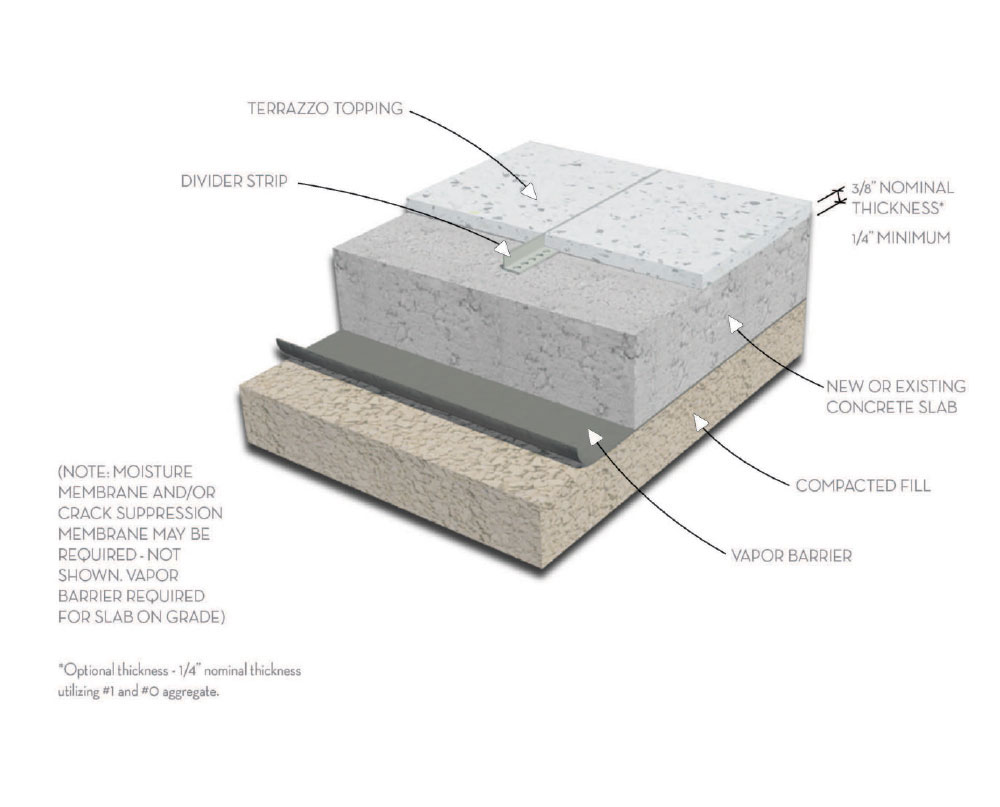
Illustration courtesy of National Terrazzo & Mosaic Association
Epoxy terrazzo, with a thin ¼-inch or 3/8-inch resin veneer, offers vibrant colors and chemical resistance with various aggregate options.

Illustration courtesy of National Terrazzo & Mosaic Association
Rustic cement terrazzo, with its non-slip, textured surface, is ideal for exterior use, offering versatile design options and weather resistance.
C. Substrate Preparation
As a poured-in-place material, terrazzo requires a flat substrate to achieve a smooth finish and a durable bond. Proper substrate preparation is vital for a terrazzo floor’s performance, longevity, and appearance. NTMA specifications require that subfloors meet a tolerance of 1/4 inch in a ten-foot span to ensure a flat finish.
Architects and general contractors can ensure a successful installation by working with an NTMA terrazzo contractor, prioritizing flatness over levelness, choosing suitable fill materials, and following best practices. A blend of epoxy and sand is commonly used as fill under an epoxy installation. Many self-leveling products are not compatible with terrazzo; their tensile strength is inadequate for the task. For example, gypsum-based floor materials can lack structural strength and disintegrate with the vibration from grinding terrazzo. Adhering to NTMA guidelines and maintaining clear communication among all parties will result in durable and beautiful terrazzo floors.
Architects and general contractors need to:
- Understand the specific requirements for substrate preparation.
- Be aware of the cost implications and potential issues of different fill materials.
- Collaborate closely with terrazzo contractors to determine critical flatness areas and where levelness can be compromised to save money without risking system malfunction.
- Ensure all parties agree on the substrate preparation method and material choices.
INSTALLATION TECHNIQUES FOR ADAPTIVE REUSE
1. Terrazzo Restoration and Renewal
An existing cementitious or epoxy terrazzo floor can be refinished, spot-repaired, or replaced in sections between divider strips. Patching and repairs can be made to a cement-based surface with epoxy terrazzo. Because terrazzo has standard specifications for mixes, repairs can be perfectly matched to existing materials. Future alterations to a building can be easily accommodated with an exact match of new epoxy to the existing color of cementitious or epoxy terrazzo or other existing design elements.
2. Pouring Terrazzo Over Existing Substrates
An old terrazzo floor may be in good shape or repairable, but for a fresh look, new terrazzo can be poured over existing cementitious or epoxy terrazzo with nominal substrate correction. If the existing floor shows minimal cracking, the cracks may be successfully treated with epoxy fill and a crack isolation membrane system to isolate the new surface against cracks telegraphing from the old floor. Brick pavers, quarry tile, marble or other natural stone, tile, or wood are also suitable as a substrate for terrazzo installation if the surface is bonded and secure.
“The main advantages are not having to tear out the old floor and that it’s shovel-ready and ready to work,” said Greg Sweetin, president of Williams Tile & Marble, Smyrna, Georgia. He explained that many of the floors they might apply terrazzo over are on a mud bed, not just on concrete, so saving the costs of demolishing a 1.5-inch mortar bed means significant savings for the client.
Keeping in the old floor can be the difference between being able to install terrazzo within budget or not. At Charleston International Airport in 2016, some 90,000 square feet of epoxy terrazzo was installed successfully directly over brick pavers. The savings for leaving in the old floor were estimated at over $1 million, according to John Wingo, senior project manager with the David Allen Company of Raleigh, North Carolina.
“Just as with pouring terrazzo over concrete, be sure the existing substrate is strong and structurally sound,” said Mr. Sweetin. He cautioned that loose tile and broken grout indicate potential problems, and terrazzo shouldn’t be applied straight over a cracking floor, nor over any“soft goods” such as carpet, VCT, or vinyl.
CONCLUSION: TERRAZZO AS A SUSTAINABLE SOLUTION IN ADAPTIVE REUSE
Terrazzo stands out as an ideal finish for adaptive reuse projects, offering a sustainable and permanent solution that is both environmentally responsible and economically sound. Its inherent resistance to abuse and moisture, coupled with its low-maintenance requirements, ensures longevity and cost savings over the lifecycle of a building. Terrazzo’s customizable and versatile nature allows for seamless integration into existing spaces, providing architects with flexible design solutions that enhance the aesthetic appeal of any environment. Whether preserving historical elements or introducing modern design, terrazzo delivers a durable, elegant, and enduring finish supporting adaptive reuse and sustainable development goals.
END NOTES
1 https://flooringlifecyclecost.tarkettna.com/.
Anna Migeon is a professional writer with nearly 20 years of experience in construction products, including terrazzo and EIFS stucco systems.



